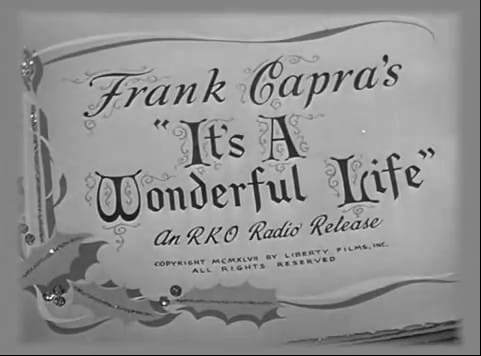Finding Truth in “It’s a Wonderful Life” (Part I of II)
Life, As I Find It
In 1945, Academy Award-winning director Frank Capra returned to feature-filmmaking after spending the previous five years serving his country during World War 2. He was nervous. Did he still have the right creative sensibilities to produce films people would want to see?
It’s remarkable to think that the man behind such classics as It Happened One Night, You Can’t Take It With You, Mr. Smith Goes To Washington and Arsenic And Old Lace could be worried. But the country had changed a lot because of the war. Capra’s blend of optimism, sentimentality and humor – called “Capra-Corn” by his detractors – might not resonate with his audience anymore.
Capra created a new production company called Liberty Films and acquired a little-known story by author and historian Philip Van Doren Stern called The Greatest Gift. Stern’s short story dealt with a man who wishes he’d never been born – and gets his wish, seeing what the world would have been like without him. RKO Studios had bought the film rights, at the insistence of Cary Grant, but couldn’t seem to make a movie out of it. They sold the rights to Capra.
Capra, who came from an immigrant Catholic background, was a sharp and intelligent man, influenced by the great American thinkers of the 19th century. His handwritten annotations on scripts quoted the likes of Thoreau, Emerson and Whitman. Inherent within most of his films was a belief in the power of the individual. His films’ protagonists often began as naïve idealists or men who were unaware of their true potential to impact their world. In the course of events, they would rise, face formidable giants in big business or the government, and prevail, often through great personal sacrifice. During the Depression, his themes struck the right chord with audiences. His films won multiple Academy Awards. His name became so much of a selling-point that it was placed above a film’s title.
 Capra saw something in the Stern story that captured his own post-War feelings and, he hoped, might resonate with his audience. Working with several writers, Capra made The Greatest Gift an American chronicle, tracing one man’s life in a small town from early in the century to a single decisive Christmas Eve in 1945 in which his attempted suicide leads to an important revelation. Capra changed the title to It’s A Wonderful Life and secured another veteran of the war, Jimmy Stewart, to play the lead of everyman George Bailey.
Capra saw something in the Stern story that captured his own post-War feelings and, he hoped, might resonate with his audience. Working with several writers, Capra made The Greatest Gift an American chronicle, tracing one man’s life in a small town from early in the century to a single decisive Christmas Eve in 1945 in which his attempted suicide leads to an important revelation. Capra changed the title to It’s A Wonderful Life and secured another veteran of the war, Jimmy Stewart, to play the lead of everyman George Bailey.
Capra’s usual themes are inherent in the film. Yet, there is something remarkably different about it. It is, in many ways, backward. Rather than draw his protagonist into heroic deeds, we see a hero who is already being heroic but doesn’t know it. George Bailey’s desire is to shake the dust of small-town Bedford Falls off his feet and impact the world as a single man. Yet he is thwarted again and again as he sacrificially saves the lives of the people around him, giving them hope and opportunities they would have been denied by circumstances or, specifically, the town’s greedy villain.
George’s individualism – a hallmark of Capra’s thinking – yields to the greater good of the community and proclaims that a life lived that way is truly wonderful. This view contradicts so many films now, in which protagonists find themselves by leaving their provincial little communities. Through George Bailey, Capra shows that our true selves are best found within community.
Capra’s Catholicism comes through in this theme and the means by which George Bailey realizes the truth. Bailey, at the end of his financial rope, reaches a point of despair that forces him to pray. He admits with tear-filled eyes that he isn’t normally a “praying man”, but he needs God’s help. When the answer to his prayer seems to come in the form of a punch in the mouth, George stumbles off to end his life. On a bridge, ready to plunge into the icy waters below, George prepares himself. But then a guardian angel named Clarence appears and bets that George’s sacrificial instincts will ultimately save him – so he jumps in the water instead. From there, thanks to George’s modified wish that he’d never been born in the first place, a revelation unfolds.
We can, of course, get nit-picky on the theological front. Angels, we know, are specifically created by God and not the spirits of departed humans (as many of Clarence’s funniest moments indicate). We could also take issue with Clarence being George’s guardian angel, but not actually participating in George’s life until this rather late moment. Though, on the positive side, we should take encouragement from the fact that the Divine Intervention that saves George’s life comes not only from George’s solitary prayer, but from the prayers of George’s family and friends heard at the very beginning of the film. The very community George doubted rallies to save him through prayer first, then by other means later.
In part II, we will look at why it seems that Pope Francis should like “It’s a Wonderful Life” and the fact that the film succeeded even when while many did not consider it a success until much, much later.
Art: Title card of the American film It’s a Wonderful Life (1946), starring Jimmy Stewart and Donna Reed. The film lapsed into the public domain in the United States due to the failure of National Telefilm Associates, the last copyright owner, to renew; 20 December 1946, PD-US, Wikimedia Commons.




